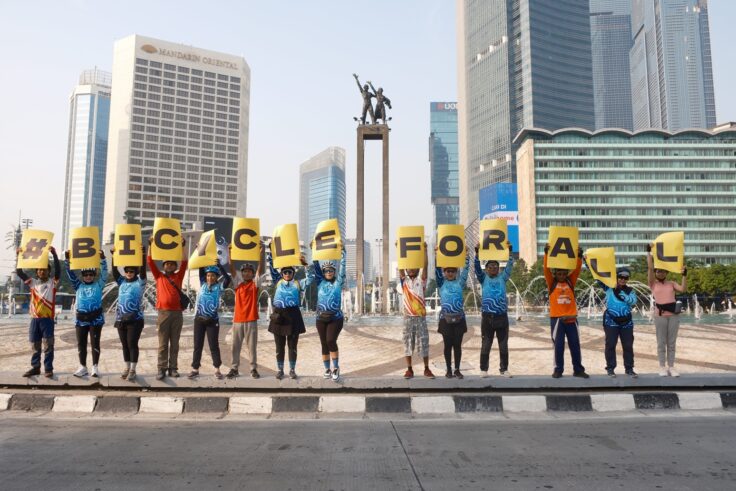January 13, 2025
Riding into 2025, We Face a Pivotal Moment for Urban Cycling
As we begin 2025, we stand at a critical point in the journey toward achieving global sustainability targets, particularly in transportation.
Watch more ITDP webinars focused on urban cycling and the campaign.
The year marks the halfway point to the 2030 Sustainable Development Goals (SDGs) and serves as an opportunity to reflect, recalibrate, and take decisive action toward transformative change. 2025 is a moment to take stock of progress and raise our ambition to ensure we meet our targets by the end of the decade. For urban transport, our focus is to reduce carbon emissions and improve the long-term sustainability of public transport, cycling, and walking. The year 2025 is also a milestone for climate financing, as the international community evaluates financing mechanisms put in place to support the Paris Agreement. We know that the urban transport sector requires much more investment in the coming years to meet both the 2030 SDGs and the 2050 Paris Agreement goals.
Though it is largely absent from conversations around decarbonization and cities, improving cycling is a key strategy many cities are pursuing to reduce emissions and support a shift away from private vehicle use. ITDP’s Cycling Cities campaign has been working since 2021 with a cohort of 34 cities, mostly in the Global South, that have prioritized cycling to address multiple urban challenges, from reducing carbon emissions to improving health outcomes and easing traffic congestion. Complementary efforts, like the Bloomberg Initiative for Cycle Infrastructure (BICI), are supporting cities with infrastructure design—a key driver for getting more people on bicycles. Furthermore, investment in cycling infrastructure as part of national and international climate mitigation efforts is steadily gaining traction. For example, the Dutch government’s €500,000 contribution to the World Bank’s Global Facility to Decarbonize Transport earmarked for cycling signals a growing recognition of the strong link between cycling and emissions reductions.

2025 will be the final year of the Cycling Cities campaign. The initiative has made significant strides in advancing cycling infrastructure and elevating the conversation around cycling as a meaningful climate, economic, and health solution. Cities that were not part of that conversation just a few years ago are now transforming their streets to capitalize on the benefits of cycling: Addis Ababa built 50 kilometers of cycle lanes in 2024; Rio de Janeiro rolled out e-bikeshare in line with the city’s low emission zone; and Merida, Mexico has been implementing its Cycling Infrastructure Plan to connect and expand existing lanes toward a more comprehensive network. These projects, along with the steady growth of the Cycling Cities network, show how collaboration and targeted investment can drive transformational change. Of course, there’s still much more to be done.
Register for ITDP’s Mastering the Cycling City Learning Hub course.
The first-hand experiences and learnings shared across the Cycling Cities network, as well as case studies and resources developed through peer knowledge networks like ACTIVE and the International Community of Practice for Cycling, provide us with a clear roadmap of what works. We know that well-designed policies, adequate funding, and sustained political will are key ingredients for success. Moving forward, the focus should be on putting these elements together and scaling up our efforts to turn more cities into cycling cities.
- Visionary policymaking: long-term policies and plans should extend beyond the political cycle and link cycling to broader goals such as economic development, climate mitigation, and public health. By connecting cycling to these other areas of public policy, we can ensure that cycling initiatives are supported across various sectors and have the political backing they need to succeed.
- Translating political will into action: it’s important to “de-politicize” cycling infrastructure projects, which can be mis-represented as unnecessary, unused, and contributing to traffic congestion. Planning infrastructure with community input and ensuring transparency from implementing agencies is critical.
- Funding infrastructure and maintenance: Direct funding and financing are critical for both the implementation and maintenance of cycling infrastructure. Oftentimes, capital investments are not supported by long-term funding for upkeep, and infrastructure can fall into disrepair, reducing use and potential benefits.

As we look toward 2025 and beyond, momentum for cycling is building. The UN Decade of Sustainable Transport, set to begin in 2026, is another opportunity to align our work with broader livability goals and ensure that cycling remains at the forefront of global urban transport discussions. ITDP also signed onto the Hamburg Charter for Inclusive and Just Mobility this year alongside global institutions and partners, advocating for barrier-free infrastructure and universal design in walking, cycling, and public transit infrastructure. As we face an inflection point for climate change and inequality around the world, it is time to for more cities, decisionmakers, and planners to work together to ensure that we can realize a vision of sustainable, livable cities, powered by cycling
Learn more about the origins of the campaign and follow the latest news of our final year at CyclingCities.ITDP.org.
